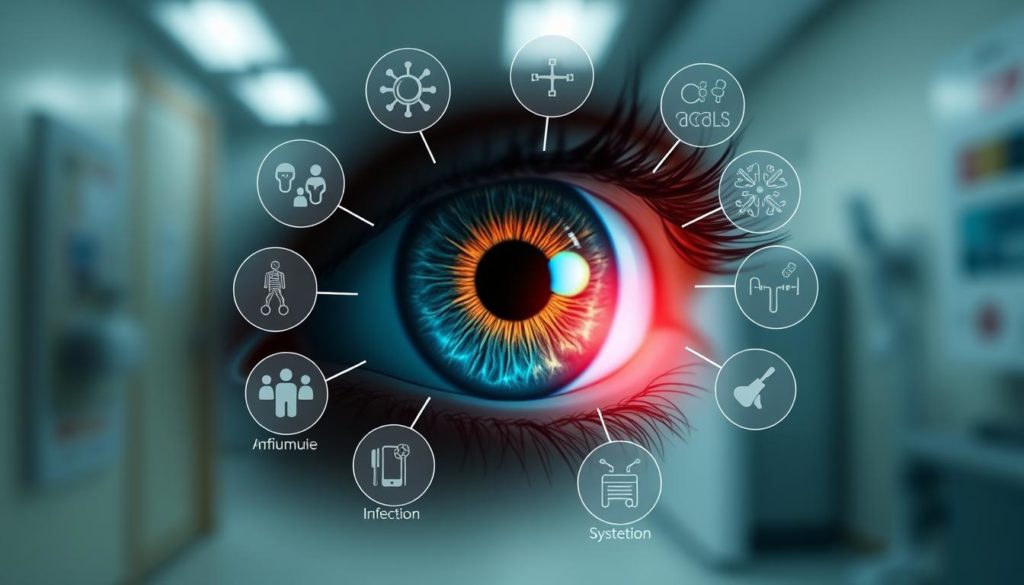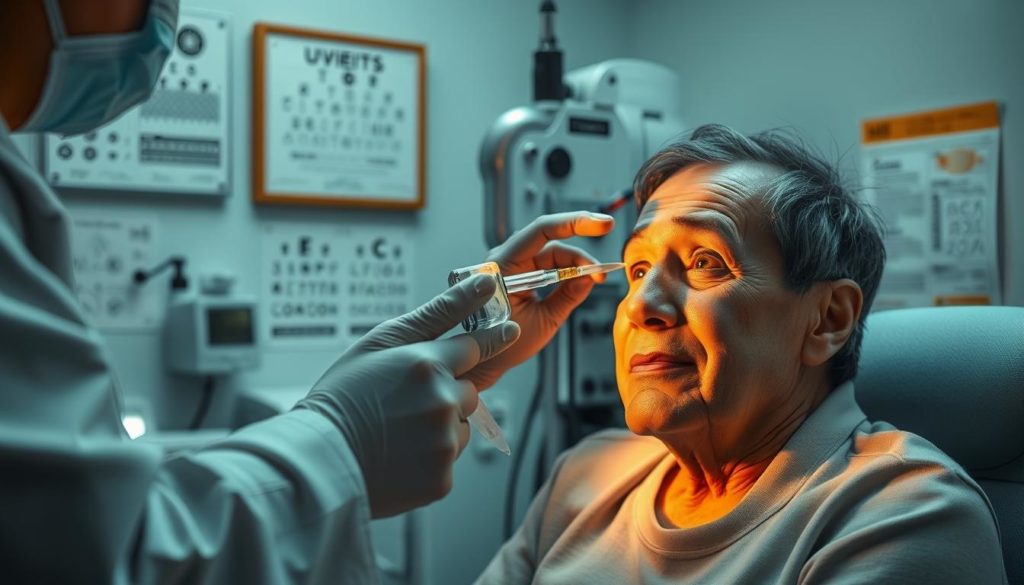“The eyes are the windows to the soul and, often, a window to your overall health.” – Dr. Patricia Bath
Uveitis, a puzzling eye condition, makes us ask: Is Uveitis a Symptom of Another Condition? Often, uveitis isn’t just a standalone issue. It can be a sign of something more serious. We need to look beyond uveitis causes and uveitis complications. We must understand how eye health is linked to our overall health.
What is Uveitis?
Uveitis is when the uvea, the middle layer of the eye, gets inflamed. This layer is key for blood flow to the retina. Knowing about this condition helps in getting it treated early.
Definition and Types of Uveitis
Uveitis is divided into four main types. Each type affects a different part of the uvea:
- Anterior Uveitis: Also known as iritis, it affects the front part of the uvea and is the most common type.
- Intermediate Uveitis: Involves the ciliary body and vitreous humor, generally affecting the middle part.
- Posterior Uveitis: Targets the choroid, retina, and blood vessels at the back of the eye.
- Panuveitis: Involves all three parts of the uvea, causing a widespread impact.

General Symptoms of Uveitis
People with uveitis may notice several symptoms. These can include:
- Redness in the eye
- Eye pain
- Blurred vision
- Photophobia (light sensitivity)
Spotting these symptoms early is key. It helps in treating the condition and improving life quality.
Common Causes of Uveitis
Knowing what causes uveitis is key for good uveitis treatment and uveitis management. Uveitis can come from infections or other reasons.
Infections Leading to Uveitis
Many infections can lead to uveitis, needing special uveitis treatment plans. The main ones are:
- Herpes Simplex Virus
- Tuberculosis
- Lyme Disease
Each infection affects how we manage uveitis and needs its own treatment. Quick action and the right treatment are vital for better results.

Non-infectious Causes of Uveitis
Other things can also cause uveitis. These include:
- Autoimmune Disorders
- Exposure to Toxins
Autoimmune disorders need a detailed uveitis management plan. This plan aims to control the immune system and watch for problems. Staying away from harmful toxins helps prevent uveitis.
Is Uveitis a Symptom of Another Condition?
Uveitis often shows that there’s something else going on in the body. Finding and treating these underlying issues is key. Let’s explore how uveitis is linked to some common diseases.
Autoimmune Diseases Associated with Uveitis
Autoimmune diseases are a main uveitis cause. Conditions like rheumatoid arthritis, ankylosing spondylitis, and lupus often come with uveitis. These diseases make the body’s immune system attack its own tissues, including the eyes.
Inflammatory Disorders and Uveitis
Uveitis is also linked to various inflammatory disorders. Crohn’s disease and sarcoidosis are examples where chronic inflammation can harm the eyes. These underlying conditions of uveitis need a detailed treatment plan, focusing on both inflammation and eye symptoms.
Genetic Factors in Uveitis
Genetics can also play a big part in uveitis. Many people with uveitis have a genetic risk factor. This, combined with environmental factors, can trigger the condition. Knowing about genetic factors helps in creating tailored treatment plans.
Diagnosis of Uveitis
Finding the cause of uveitis takes several steps. It begins with a detailed first meeting and a full medical history.
Initial Consultation and Medical History
The eye doctor will ask many questions during the first meeting. They want to know about any vision changes, eye pain, and health issues. This helps find clues for diagnosing uveitis.
It’s important to gather a complete medical history. The doctor will ask about your family, recent infections, and autoimmune diseases. They also want to know about your medications. This helps figure out if anything might cause uveitis or make it worse.
Diagnostic Tests for Uveitis
After the first meeting, several tests are done to diagnose uveitis. A key test is the slit-lamp exam. It lets the doctor see the eye’s structures closely, looking for signs of uveitis.
Measuring eye pressure is also crucial. Changes in pressure can be a sign of uveitis and might lead to glaucoma. Tests like Optical Coherence Tomography (OCT) and fluorescein angiography give detailed images. They help understand how severe the uveitis is.
Getting a uveitis diagnosis early is key. It helps treat the condition well and prevent future problems. Knowing the causes and symptoms means doctors can act fast, reducing long-term risks.
Management and Treatment of Uveitis
Managing and treating uveitis needs a mix of medicine and other treatments. We’ll look at the main ways to control this eye issue and lessen its problems.
Medications Used in Uveitis Treatment
Effective uveitis treatment often includes medicines to cut down inflammation and manage symptoms. Here’s a rundown of the primary medications used:
- Corticosteroids: These are commonly prescribed to quickly diminish inflammation. They can be administered as eye drops, oral tablets, or injections.
- Immunosuppressive Drugs: For cases where corticosteroids are insufficient or cause side effects, immunosuppressants help reduce immune system activity.
- Biologic Response Modifiers: These newer agents target specific immune pathways, offering another layer of uveitis management for those who don’t respond to standard treatments.
The side effects of these medicines can vary. Corticosteroids might raise blood pressure, while immunosuppressive drugs could increase infection risks. It’s crucial for healthcare professionals to closely monitor these effects.
Non-Medical Therapies for Uveitis
Along with medicine, non-medical therapies are key in a complete uveitis management plan. These alternatives help reduce symptoms and prevent future flare-ups:
- Lifestyle Modifications: Making dietary changes, reducing stress, and avoiding smoking can significantly help manage inflammation levels.
- Specialized Eyewear: Glasses with protective lenses can shield eyes from harmful UV rays and blue light, reducing discomfort during flare-ups.
- Physical Therapy: Eye exercises and therapies can enhance eye health and function, providing additional relief.
Using these therapies with regular check-ups can tackle uveitis complications effectively. This ensures a well-rounded treatment approach.
Complications Resulting from Uveitis
Understanding the long-term risks of uveitis is crucial. If not treated well, uveitis can cause serious problems. This highlights the need for early diagnosis, consistent treatment, and close monitoring.
Vision Impairment and Blindness
One major uveitis complication is vision loss. Inflammation can harm eye tissues, affecting how well you see. Spotting uveitis symptoms early and following a strict uveitis management plan can help avoid this.
Secondary Glaucoma and Cataracts
Managing uveitis also means watching for secondary issues like glaucoma and cataracts. Uveitis can raise eye pressure, causing glaucoma. Cataracts might also develop from the disease or treatments. Seeing an eye doctor regularly helps catch these problems early.
Preventing Uveitis
Preventing uveitis starts with early detection and reducing risk factors. Regular eye exams and lifestyle changes are key. They help manage this condition well.
Regular Eye Examinations
Getting regular eye check-ups is vital for catching uveitis early. Early detection leads to better treatment and management. It’s especially important for those with pre-existing conditions.
Lifestyle Adjustments and Uveitis
Living a healthier lifestyle can help prevent uveitis. Quitting smoking, eating well, and managing stress are important. These habits not only improve your health but also help manage uveitis.
Living with Uveitis
Living with uveitis means finding ways to cope every day. It’s about adjusting to new visual challenges or dealing with chronic pain. There are many strategies to help ease the burden of this condition.
Coping Mechanisms for Uveitis Patients
Patients can use several ways to manage uveitis symptoms. Visual aids can make daily tasks easier. Techniques like prescribed meds and alternative therapies like acupuncture and yoga are also helpful.
- Visual Aids: Devices like magnifying glasses and special lighting can help with visibility issues.
- Pain Management: Medications prescribed as part of the uveitis treatment are critical. Complementary therapies like meditation play a beneficial role.
- Mental Health Support: Counseling and support groups can assist with the emotional strain related to uveitis management.
Support Systems and Resources
Support systems are crucial for managing uveitis. Patient networks and advocacy groups offer community support and educational materials.
- Patient Networks: Organizations such as the American Uveitis Society offer communities where patients can share experiences and advice.
- Advocacy Groups: Groups like the Uveitis Information Group advocate for better uveitis treatment options and increased awareness.
- Educational Resources: Available resources can help patients stay informed about recent developments and effective uveitis management strategies.
| Resource Type | Description |
|---|---|
| Patient Networks | Communities to share experiences and advice |
| Advocacy Groups | Organizations pushing for better treatment options |
| Educational Resources | Information on the latest research and management strategies |
Research and Future Directions in Uveitis
Research is making big strides in fighting uveitis. New studies show the power of novel therapeutic approaches and tech in treating uveitis better.
“Research currently focuses on improving the accuracy of uveitis diagnosis and developing targeted therapies that minimize side effects,” states Dr. Emily Knight from the American Academy of Ophthalmology.
Today’s clinical trials are finding new drugs for uveitis. Biologics and immunomodulatory drugs are showing great promise. They fight inflammation well and have fewer side effects. Gene therapy is also being looked into as a future option.
New tools like optical coherence tomography and fundus autofluorescence are helping with diagnosis. These tools let doctors spot inflammation early and accurately. This is key for managing uveitis well.
| Key Advancement | Impact on Uveitis |
|---|---|
| Biologics | Targets specific components of the immune response, reducing inflammation effectively. |
| Gene Therapy | Potential to provide a long-lasting solution by addressing the underlying genetic factors. |
| Optical Coherence Tomography | Allows for detailed imaging of the retina, aiding in accurate diagnosis and ongoing monitoring. |
The medical world is dedicated to improving uveitis treatment and management. With ongoing research and tech, the future looks bright for those with uveitis.
When to See a Doctor for Uveitis
Recognizing early signs of uveitis is crucial for effective treatment. Persistent eye redness is more than just annoying; it could signal uveitis. Eye pain or sensitivity to light are also warning signs.
Your eyes are your gateway to the world. Blurred vision or seeing floaters are serious symptoms. If you notice these, get an eye exam right away. Early diagnosis can prevent serious problems and help find the right treatment.
It’s urgent to see a doctor if symptoms don’t go away or get worse. Waiting too long can cause permanent vision loss or eye damage. Treatment for uveitis might include medication, lifestyle changes, or surgery. Seeing a doctor early helps protect your vision and eye health.
FAQ
Is Uveitis a Symptom of Another Condition?
Yes, uveitis can be a sign of other diseases. Autoimmune disorders, infections, and genetics can cause it. Finding the cause is key to treating it right.
What are the main types of Uveitis?
Uveitis is divided into four types: anterior, intermediate, posterior, and panuveitis. Each type affects different parts of the eye. They have unique causes and symptoms.
What are the general symptoms of Uveitis?
Common symptoms include eye redness, pain, blurred vision, and light sensitivity. These signs vary by type and need quick medical attention.
What are some infections that can lead to Uveitis?
Infections like herpes simplex virus, tuberculosis, and Lyme disease can cause uveitis. Treating the infection is crucial to manage uveitis.
Can non-infectious factors cause Uveitis?
Yes, non-infectious causes like autoimmune disorders and toxins can also lead to uveitis. Identifying these triggers is important for managing uveitis.
How are autoimmune diseases related to Uveitis?
Autoimmune diseases like rheumatoid arthritis and lupus can cause uveitis. These diseases make the body attack its own tissues, including the eye.
What role do genetic factors play in Uveitis?
Genetics play a big role in uveitis. A family history of autoimmune diseases or eye conditions raises the risk of getting uveitis.
What diagnostic tests are used for Uveitis?
Tests for uveitis include a slit-lamp exam, ocular pressure checks, and imaging like OCT and fluorescein angiography. These help find the cause and extent of inflammation.
What medications are typically used to treat Uveitis?
Treatments include corticosteroids to reduce inflammation, immunosuppressive drugs, and biologic response modifiers. The choice depends on the cause and severity of uveitis.
Are there any non-medical therapies for Uveitis?
Yes, non-medical therapies include lifestyle changes like quitting smoking and managing stress. Specialized eyewear can also help manage symptoms.
What complications can arise from untreated Uveitis?
Untreated uveitis can cause vision loss, blindness, secondary glaucoma, and cataracts. Early treatment is crucial to avoid these complications.
How can Uveitis be prevented?
Preventing uveitis involves regular eye exams and lifestyle changes. Avoiding smoking and a poor diet can reduce the risk of uveitis.
How do patients cope with Uveitis?
Patients use visual aids, pain management, and mental health support. Patient networks and advocacy groups offer additional support and information.
What are the latest research directions in Uveitis?
Research focuses on new treatments and diagnostic tools. New drugs and technologies aim to improve patient care and outcomes.
When should one see a doctor for Uveitis?
Seek medical help if you have eye redness, pain, blurred vision, or light sensitivity. Quick action can prevent further problems.


